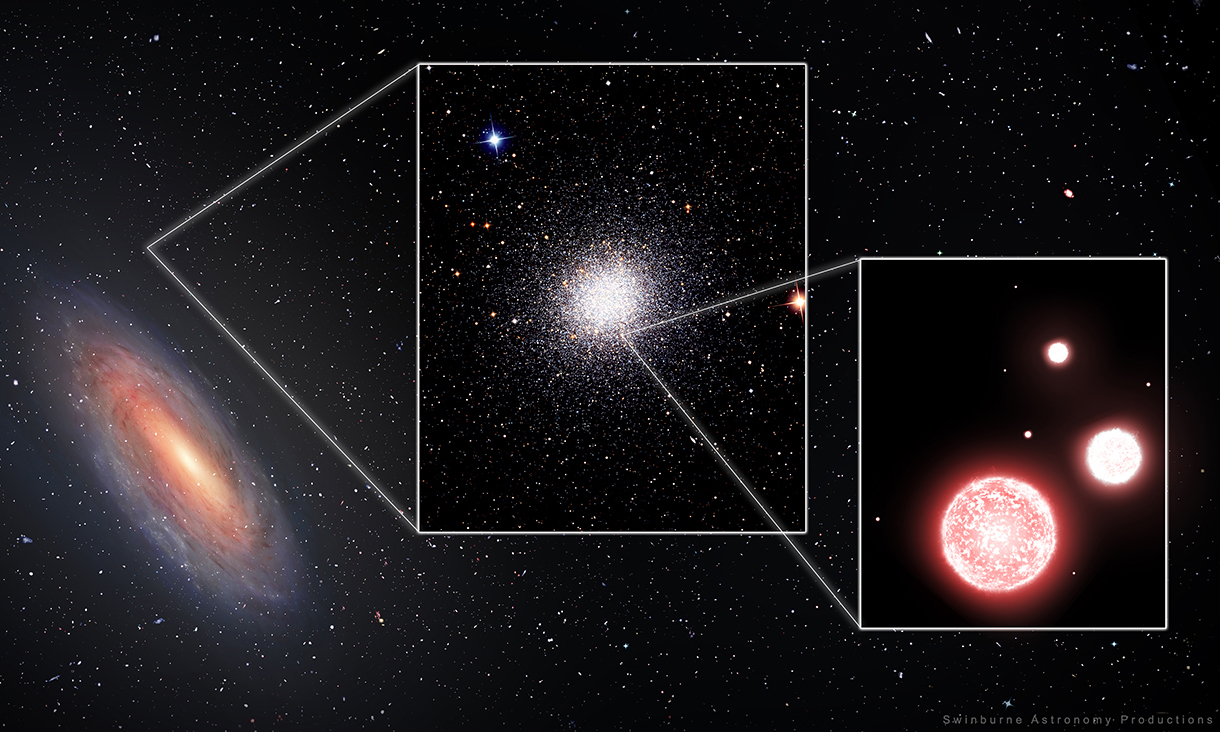Astronomers discover metal-poor globular cluster

Artistic representation of the Andromeda Galaxy with globular cluster RBC EXT8 and its metal-poor stars. Globular clusters contain some of the oldest stars in a galaxy.
In summary
- Astronomers have found a globular star cluster with a record-breaking low amount of metals
- Globular clusters are key components of galaxies thought to form very early in the history of the Universe
- The cluster of stars was found in the halo of the Andromeda galaxy
An international team of astronomers including Director of Swinburne’s Centre for Astrophysics and Supercomputing (CAS), Professor Jean Brodie, has discovered a globular cluster of stars that contains extremely few metals.
The interesting cluster of stars was found in the Andromeda galaxy. Galaxies, like Andromeda and the Milky Way, are massive systems made of billions of stars, gas, dust and dark matter.
So why is one group of stars so important?
“Stars tell us important things about galaxies and their history, helping us understand more about how they form and change over time,” says Dr Rebecca Allen, a galactic astronomer at CAS, not associated with the study.
This system of stars (about a million of them in a spherical bundle) is what astronomers call a globular cluster. It is located in the outskirts, or halo, of the Andromeda galaxy. Globular clusters are key components of galaxies thought to form very early in the history of the Universe. They are bright fossils that trace the mergers and acquisitions that build up the galaxies we see today.
Until now large globular clusters all contained at least a certain amount of metals, which set limits on where and when they could have formed. As galaxies evolve and grow over time, stars are formed and die, increasing the quantity of heavy elements present in the galaxy. The more massive a galaxy is the more metals it should have.
This is where the globular cluster, called RBC EXT8, comes in. It is extremely metal poor, but also massive. The stars in the cluster have, on average, 800 times less iron than our Sun and are three times more iron-poor than the previous globular cluster record-holder. EXT8 is also extremely deficient in magnesium.

Director of the Centre for Astrophysics and Supercomputing, Professor Jean Brodie.
“As a high-mass cluster, it should have been made by a relatively high-mass galaxy, which in turn would have a relatively high metallicity,” says co-author of the study, Professor Brodie.
“The issue is that very low metallicity clusters are expected to form in very low-mass galaxies, which can make only low-mass clusters. Such clusters would then have dissolved by the present day.
“This discovery is exciting because the idea of a ‘metallicity floor’ for globular clusters, that must contain some minimum amount of heavy metals, underpinned so much of our thinking about how these very old star clusters formed in the early Universe.
“Our finding contradicts the standard picture and that is always fun!”
The findings are published in the journal Science.
-
Media Enquiries
Related articles
-

- Astronomy
High school students work with Swinburne astronomers on the future of space
Swinburne’s Youth Space Innovation Challenge has inspired over 330 Australian teenagers to pursue a career in STEM.
Friday 26 July 2024 -

- Astronomy
- Science
Swinburne appoints new Director of Innovative Planet Research Institute
Leading geodesy expert, Professor Allison Kealy, has been appointed as the inaugural Director of Swinburne University's Innovative Planet Research Institute.
Monday 22 April 2024 -

- Astronomy
- University
OzGrav 2.0: A ‘new era of astrophysics’ launched at Swinburne
The next phase in the world-leading ARC Centre of Excellence for Gravitational Wave Discovery, dubbed 'OzGrav 2.0', launched this week at Swinburne University of Technology.
Wednesday 17 April 2024 -

- Design
- Astronomy
- Technology
- University
Swinburne ‘Rock Muncher’ takes part in Australian Rover Challenge
A multidisciplinary student team from Swinburne University of Technology competed in the 2024 Australian Rover Challenge held in Adelaide, South Australia.
Thursday 11 April 2024 -
.jpeg/_jcr_content/renditions/cq5dam.web.256.144.jpeg)
- Astronomy
New JWST observations reveal black holes rapidly shut off star formation in massive galaxies
New research showcases new observations from the James Webb Space Telescope that suggest black holes rapidly shut off star-formation in massive galaxies by explosively removing large amounts of gas...
Tuesday 23 April 2024

